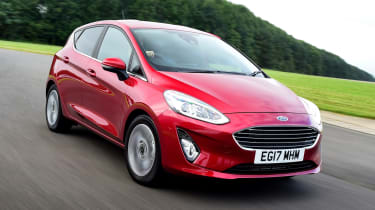Used Ford Fiesta (Mk7, 2017-2023) review
A full used buyer’s guide on the Ford Fiesta covering the Fiesta Mk7 (2016-2023)
Verdict
Across Europe, more superminis are bought than any other type of car, so the stakes are high. The fact that the Fiesta is consistently one of the UK’s best-sellers just goes to show that Ford has got the formula right. While some earlier editions were clearly built down to a price, the latest Fiesta feels like a high-quality product – especially if you buy further up the range. Thankfully, despite some steep asking prices for these posher models, there’s no shortage of high-spec used Fiestas, while if you want something unusual, the Fiesta Active pseudo-off-roader might be worth a closer look. But never overlook a nicely kept mid-range Fiesta at the right price – it really is a superb car.
When Ford launched its first-ever front-wheel-drive small hatchback in 1976, it probably didn’t realise just how significant the model would become. Or maybe it did, because that first Fiesta set a template that Ford has followed ever since.
In the intervening 44 years there have been another seven generations of Fiesta. All of these have focused on practicality and affordability, with a healthy dose of driving pleasure thrown in for good measure. Another thing that’s remained constant is the wide model range that ensures there’s a Fiesta for everyone, whether their priority is economy or performance – or a mix of both.
Used - available now

2023 Audi
Q4 Sportback e-tron
54,526 milesAutomaticElectric
Cash £23,363
2022 Kia
Niro
18,315 milesAutomaticPetrol1.6L
Cash £17,900
2023 Nissan
Juke
40,858 milesManualPetrol1.0L
Cash £12,287
2022 Volkswagen
T-Roc
36,779 milesAutomaticPetrol1.5L
Cash £18,600When the Fiesta Mk8 was unveiled at the end of 2016, it was the cleanest, safest, most spacious and most efficient edition yet – which is why it’s a car you can buy with your head, as well as your heart.
Model covered
- Ford Fiesta Mk7 (2016-2023) - This supermini is a big-seller for good reason – and here’s how to get the best used example to suit you.
History
The seventh-generation Fiesta was unveiled in November 2016, with UK cars arriving the following July. Priced from £12,715, it was available with a non-turbo 1.1-litre petrol engine in 69bhp or 84bhp forms, or a 1.0 turbo boasting 99bhp, 124bhp or 138bhp. Diesel fans could opt for a 1.5 TDCi with 84bhp or 119bhp; only the 99bhp 1.0 EcoBoost petrol was available with an auto.
Things got more interesting in March 2017 with the unveiling of the 197bhp Fiesta ST, but the first cars wouldn’t reach the UK for another year. As with the less sporty Fiestas, the ST came with three or five doors, and was offered with ST-1, ST-2 and ST-3 trim levels. In July 2019 the Zetec trim was superseded by Trend.
Vicki's verdict
“The Ford Fiesta has been part of our motoring history since 1976. As an owner of a 1978 one, and a tester of every model since, I can vouch for the easy and engaging driving experience they offer. The Mk7 Fiesta is rightly the benchmark car for the class - with my pick of the bunch being the hot ST, or a well-maintained mid-range model.” - Vicki Butler-Henderson
Which one should I buy?
The non-turbo 1.1-litre engine feels rather lacklustre, and while it’s perfectly good, it lacks the perkiness of the alternatives. The diesel is worth considering if you’re a high-mileage driver, although we’d stick with a manual gearbox, because the automatic transmission isn’t nearly as slick.
Entry-level Style has steel wheels, but it does get air-con, electric front windows and mirrors, plus Bluetooth. The Zetec adds 15-inch alloys, a heated windscreen, Apple CarPlay and a 6.5-inch touchscreen, while Titanium brings 16-inch alloys, privacy glass, eight-inch touchscreen, climate and cruise control, keyless go and auto wipers.
With the Titanium X you get powered rear windows on five-doors, part-leather trim, heated front seats and wheel, plus premium audio. ST-Line trim has 17-inch alloys, sports suspension and seats, plus a bodykit. Vignale brings quilted leather, a panoramic sunroof and a high price.
Alternatives to the Ford Fiesta
Most mainstream brands offer a supermini, so there’s plenty of choice. In terms of low prices, decent value and ready availability, the Vauxhall Corsa stacks up pretty well, but it’s not as much fun to drive as the Fiesta. The inter-related Volkswagen Polo, SEAT Ibiza and Skoda Fabia are well made, easy to live with and feature efficient engines.
While the Renault Clio and Peugeot 208 offer decent value with an enjoyable drive, the Hyundai i20 and its cousin the Kia Rio major on reliability and value, plus longer than average warranties. Don’t overlook the Suzuki Swift, either; it’s fun, reliable and great value. The MINI hatch and Audi A1 are worth a look, too, but you’ll pay more for one of these than an equivalent Fiesta.
What to look for
Gearbox
Turbocharged Fiesta engines come with a six-speed manual gearbox as standard, but the 1.1-litre only gets a five-speed transmission.
Fuel economy
Fiesta ST drivers average around 28-35mpg, but Ford claims 40.4mpg is possible. Meanwhile, 1.0T owners average 46mpg.
Warranty
The Fiesta has a three-year or 60,000-mile warranty, which could be extended to five years or 100,000 miles when the car was purchased new.
Interior
The Fiesta is now Ford’s smallest car, but that doesn’t mean its interior is short of space or gadgetry. There’s room for two adults in the back – albeit with a bit of a squeeze for those over six feet tall – while the Fiesta also comes with plenty of hi-tech driver-assistance systems. The fit and finish are excellent, as are refinement levels, and the dash design is also generally appealing.
Boot space is competitive at 292 litres with the rear seats up, or 1,093 litres with them folded. Some claim the front seats in the standard Mk7 aren’t quite as supportive as those in the previous Fiesta – but there’s no issue with the ST’s sport seats, though.
Running costs
Fiesta owners can choose between servicing schedules: either 12 months or 12,500 miles (whichever comes first), or two years or 18,000 miles. Services alternate between minor and major, with prices for the annual schedule set at £215 and £295 respectively. They’re £245 and £335 if you opt for the long-life regime.
Once a Fiesta reaches its third birthday, Ford offers a discounted maintenance scheme called Motorcraft, with a service priced at £159. All engines have a cambelt that should be replaced every 10 years or 125,000 miles – although we’d be inclined to bring this slightly forward just to be safe. It’s not an especially cheap job, with Ford dealers charging £475 to replace just the belt, or £540 if you want a fresh water pump fitted, too. Not renewing the latter is generally considered to be a false economy.
Recalls
The Ford Fiesta Mk8 has been recalled three times since launching in 2017. The manufacturer implemented its first campaign in March 2018, to get 4,757 Fiestas back into dealers in order to replace a faulty brake servo. The affected cars were all manufactured in December 2017.
The next recall was much smaller, affecting a mere 15 Fiestas, and was issued in December 2019. This time the problem was that the retaining bolts for the rear seat may not have been tightened sufficiently, allowing the seat to work loose. The cars affected were all made in one week during September 2019.
Finally, the most recent recall came in January 2020; just 90 Fiestas were affected, all built in May or June 2019. The problem centred on faulty steering columns, and the solution was to replace the part in its entirety.
Driver Power owner satisfaction
We’re big Fiesta fans, giving it four stars out of five. Its shine already seems to be fading with owners, though, because it managed only a 71st-place ranking in the 2020 Driver Power satisfaction survey. There are no stand-out features, with the quality of the steering getting the highest mark (18th out of 75 cars). Reliability and build quality also score reasonably well, while the lowest score is for interior versatility












